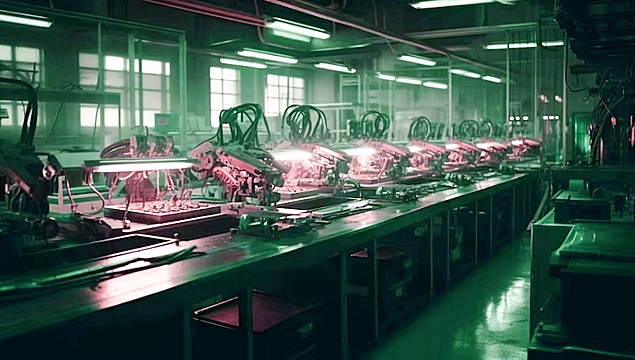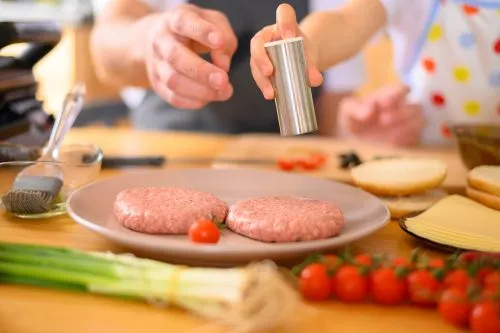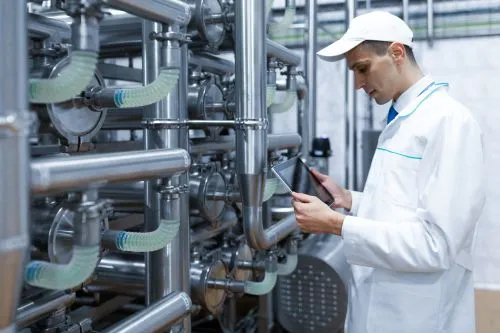
The tools used in the meat industry vary widely, from simple knives handled by the butcher, to autonomous systems for complex tasks such as evisceration or optimally breaking the carcass. Although grammatically the term automation can be used interchangeably with the term mechanization, it is more common to use mechanization to describe simple powered equipment that has little sensing or adaptation to the load or workpiece and automation to describe more advanced, sensory guided, with adaptive cars. A number of approaches can be incorporated into automation to solve product variation problems in a number of ways. Some use advanced sensors, others use stored knowledge of statistically probable variations, and the third category modifies the process to use the power of machines, as shown in the paper "Advanced Technologies for Meat Processing" by Leo Nollet and Fidel Torda.
Dedicated equipment
Mechanization includes simple powered devices with little or no detection, such as overhead rail for transporting carcasses around the slaughterhouse or mechanical splitting saws, which remove the need for human effort. Such items are exceptionally useful and vital to the flow of the modern slaughterhouse, but are not considered automation.
The justification of automation in production is a complex process, mainly dependent on the pace of production and the flexibility required for the process. Although mechanization is suitable for manufacturing industries with consistent products such as automotive, electronics and so on, the inherent biological variability of animals requires more sophisticated automation processing solutions.
High production rates are favored by dedicated machines that tend to be inflexible. High process flexibility can be achieved with human staff, but with lower flow rates and greater processing variation that must be tolerated. Automation, using robotic devices, is suitable for medium-rate production in slaughterhouse operations.
Simple automation, such as a simple sensor-controlled door or touchless faucet, can make a significant difference with only a small outlay and minimal risk. However, this chapter considers larger, heavy duty processing systems in the pork, lamb and beef slaughter production line.
Although the specific methods of cutting and dressing vary around the world, the same basic processes are required to produce pork, beef and lamb carcasses.
Generic drivers
There are a wide variety of commercial and quality reasons that lead many companies to investigate and implement automation of meat production lines. At the end of the day, all processors have the same goal: increasing profitability. If no long-term profit or benefit is foreseeable, no changes will be implemented.
The use of automation in the slaughterhouse instead of human operators has many potential benefits, which could be tangible, intangible, social or economic. Many generic drivers are cited by the meat industry for the introduction of automation, including the following:
• Difficulties in staff recruitment. There is a shortage of skilled labor to perform tasks in the meat industry. The work is usually repetitive, physically demanding and performed in an unpleasant environment.
• Staff safety and welfare. Removing staff from repetitive and high concentration leads to greater job satisfaction and reduced risks of accident or repetitive strain injury. Injuries occur in the experienced as well as the newly trained, illustrating that it is the nature of the work rather than inexperience that causes the danger.
Cuts made with high force to the body, knife design and cold fingers contribute to the low level of safety (North 1991). In an increasingly litigious society, the cost of employer liability provides an additional concern.
• Food safety. The human operator is a major factor in microbial introduction and foreign body contamination. The costs of maintaining hygiene with the large number of personnel present in a normal meat plant increase the overall production costs.
• Production quality. It is widely accepted that meat is best cut at temperatures between 2 C and 5 C. As temperatures decrease, cut quality improves but cutting forces increase (Brown, James and Purnell 2004), to an extent in which manpower might be insufficient to maintain production rates. Automation can be used to exert greater forces, maintaining or improving reducing quality and production rates.
• Product consistency. Automation usually performs a task more consistently than a human. Boredom, stress and fatigue are not a problem.
• Process control. Automation can make subtle adjustments beyond the competence of a human agent and is not endowed with memories, reasoning or other human capabilities, but they have other capabilities such as for example infrared detection, increased power, x-ray vision, immense memory, etc. .. Machines can be designed to perform in conditions where humans could not perform efficiently. It can allow processing in quality-beneficial environments (eg, low temperatures, aseptic atmospheres, etc.). In addition, automation reduces waste and increases overall yield.
• Legislation. The legal minimum continuous working temperature for an active standing worker in the EU is 10 C. European Economic Community (EEC) Directive 95/23/EC states that during meat cutting, temperatures must not exceed 7 C and processing rooms must to be at most 12 C. Automation and robotics can work closer to optimal temperatures than can legally be achieved with human operators.
• Traceability. Traceability is increasingly important throughout food production, and processes and meat are no exception. Although the sensory information inherently required to automate many tasks could provide the opportunity to collect traceability data in a natural, uncontrolled manner, the application of automation can adversely affect traceability systems.
The risks of automation
Over the past decade, many of the technological barriers to automating meat production have been reduced or eliminated. Business and commercial factors are now the predominant limiting factor. The automotive industry has been very successful in implementing automated processing. Common components and high value together produced an ideal process for automation.
Despite product and process differences, some business experiences and observations can be transferred to the meat sector. That's why a longer-term, less risk-averse company culture is needed and employees at all levels need to be prepared to change. Where automation projects have failed is often a lack of company-wide buy-in and lack of awareness of the skills and organizational change needed to support implementation.
The same organizational risks apply to the food sector, with the additional challenges of high product variability and a restrictive market structure. The low margin on most meat products reduces the money available for investment, and a market dominated by several major retailers exacerbates the situation. The majority of the workforce in the food sector is unskilled and therefore savings in labor substitution are low.
A positive mindset
Supply, demand and processing specifications are flexible, seasonal and regional. From an automation point of view, the complexity of case manufacturing tasks should not be underestimated. Human staff members are innately dexterous, flexible, and well-endowed with integrated sensors. Most tasks in meat production utilize these inherent skills.
In contrast, most automation systems have limited decision-making and limited ability. Humans are excellent at assessing situations and acting accordingly. A machine system has a predestined function and a correction for only a limited number of possible errors that can be built into the design. Any automated system to replicate, even a small subset of human skills, may require sophisticated systems integration.
Many food plants today lack the in-house skills to specify and support system automation. The skills required extend beyond the engineering function to the specific one that installs and maintains the system. Management and production personnel work alongside automated systems that must understand the strengths and weaknesses of equipment and adjust practices accordingly.
The entire organization, from butchers to managers, must adopt a positive mindset towards automating traditional manual operations. Inappropriate attitudes at any of the many levels can cause automation projects to fail.
Causes of rising costs
A traditionally conservative, staff-poor, low-margin meat industry has some fundamental financial and business attitudinal challenges in implementing systems automation. Despite the progress made in recent years in the field of meat automation, the biggest technical problem is still to deal with the natural biological variation in the product.
Variable products require variable production strategies and flexible processing methods. This has implications for detection systems and system elements in contact with meat, such as fasteners, clamps and cutting tools. The products are relatively delicate and can be damaged by improper handling.
These factors tend to preclude direct technology transfer from other industries. The secondary technical challenge is in the longevity and suitability of food production equipment and environments.
Hygienic and robust systems to withstand high pressure washing, in a cold environment and condensation, can be designed and built, but at additional cost and high complexity. This further increases the costs of implementing automation for food production.
Advanced technologies for automated meat processing
Automation technology is still far from the general robotic system capable of replacing humans in most food operational situations as envisioned by Khodabandehloo and Clarke (1993).
For a typical meat production task, the operator uses his senses to evaluate each input product and compare it to the required output product. Then, using the experience gained from the previous performance of the task and an appropriate tool, the operator performs the necessary processing actions.
Throughout the process, the operator senses effort and reacts to changes to complete each action. Similar process steps and requirements are required for an automated system to complete the task. Sensors are needed to obtain information about each individual section of meat and monitor progress during pregnancy. A task description is therefore required to interpret specific information and produce an action plan, and an actuator is required to perform the required process in the meat section.
Various levels of intelligence and feedback are required to adapt to process variation and react to errors. Data interpretation and control functions are common to automation systems in many industrial sectors. Key developments for automation in the food industry are in the sensing and end-effector subsystems or instruments that interact directly with the meat.
Cutting and separating are the most common operations in carcass disassembly during the slaughter process. A number of new cutting methods such as lasers, water jets and ultrasonic instruments have been investigated for automatic meat cutting. However, mechanical blades are the most common cutting method. These are robust and well-accepted tools, although the basic science of their cutting action is still to be fully understood (Brown et al. 2004).
Waterjet cutting has a small niche in cutting flat products such as fish and poultry fillets, but is not commonly used in red meat production. The predominant sensing subsystem used in meat industry automation is machine vision.
Many manufacturers have equipment that is suitable and used in the food sector. Imaging devices can be placed remotely from the operating site and thus removed from the rigorous cleaning regimes that must be endured by equipment in close direct contact with the meat. Vision is also highly applicable to the complex data mining required to enable intelligent processing of meat products.





